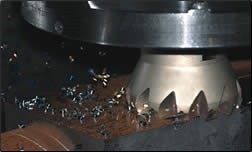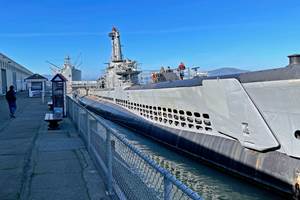Realizing Large-Scale Savings On Large-Scale Parts
Converting big square bars to largely round tie bars used to require 24 hours per piece at Oak Products. The Sturgis, Michigan, company can now complete the same job in 8 hours. How did the company slash its machining times and realize substantial cost savings? Oak attributes the turnaround to process re-engineering involving aggressive mill-turning and tooling geared to stand up to the challenge.
Converting big square bars to largely round tie bars used to require 24 hours per piece at Oak Products. The Sturgis, Michigan, company can now complete the same job in 8 hours. How did the company slash its machining times and realize substantial cost savings? Oak attributes the turnaround to process re-engineering involving aggressive mill-turning and tooling geared to stand up to the challenge.
The application involves big tie rods that become the four corners of specialized stamping presses. These presses are then used to form cooling fins for HVAC equipment. The company produces about 320 of these per year, in a range of sizes. Each rod starts out as an 8-foot-long by 6-inch square bar of hot rolled steel, and it ends up as a round journal with a 2-foot square section in the middle. The entire exterior is machined.
Oak once fabricated the tie rods on a variety of machines, moving the parts progressively between lathes and mills. A conventional lathe operation performed rough tooling with stationary tools. During the 24-hour machining cycle, the parts were chucked into place more than half a dozen times.
Now the parts can be machined in one setup in a fraction of the time previously required. The shop says that it has been able to achieve this using an Integrex E650HS mill-turn center from Mazak Corp. (Florence, Kentucky) and Hi-PosDeka face mills from Ingersoll Cutting Tool Co. (Rockford, Illinois). All of the rough turning is executed by a mill-turn process using the high-density face mills. The company credits about 20 percent of the 16-hour unit time savings to the new roughing tools.
“The most punishing part of the job is to rough the square into a round over three quarters of the tie rod’s length,” says Art Givens, manufacturing engineer at Oak. “Reducing a square cross section into a round by conventional turning involves coarse interrupted cuts. This creates shock loads that can deflect the workpiece, ruin tooling and damage the machine.”
Not surprisingly, the biggest bottleneck the company noticed when starting the new process was tool failure during the rough-turn operation. “All of the 90-degree roughing face cutters we tried produced too much face pressure and actually hopped along the face of the part,” Mr. Givens explains. “No tool lasted long enough for us to figure tool costs, even after reducing feeds and speeds to low levels.”
During a shop visit with Greg Anderson of S&S Industrial Supply, Ingersoll’s Tom Noble identified the problem, and he suggested the new Hi-PosDeka cutter with a 20-degree lead angle and 12-insert density. Mr. Noble surmised that the combination would reduce cutting forces and chip load per tooth while ramping up metal removal rates.
Oak attempted this first on the flat sections. Mr. Noble and Mr. Anderson spent 2 days on the plant floor with Mr. Givens and Korey Johnson, CNC machinist, optimizing the operation to increase throughput while maintaining reasonable insert cutting life. They settled on a 4-inch, 12-insert cutter running at 755 rpm, 180 ipm and 0.080 inch DOC. Cutting cycle time for roughing the flats dropped by more than 2 hours. In addition, edge life improved by more than 50 percent. These settings were so effective that the company still uses them today.
Converting to the same face mills for mill-turning the round sections was Oak’s next step. The company now roughs the tie rods with the mill-turn head set at 790 sfm, 90 ipm and 0.125 inch DOC, with the workpiece rotating at approximately 5 rpm. At these settings, roughing is completed 4 to 6 hours faster than before, with insert cutting life hovering around 25 minutes.
To improve the latter operation, Mr. Givens moved the mill-turn infeed axis slightly off-center from the workpiece centerline using an internally-developed formula to calculate the correct position. He says that this created a better presentation angle for the cutting edge at the point of contact, thereby reducing cutting forces.
The Integrex machine was also a crucial part of the company’s solution. The mill-turn head on the machine offers 50 hp and spindle speeds as fast as 10,000 rpm.
“The Mazak provided the speed and power necessary to rough the tie bars quickly,” Mr. Givens says. “That was not a concern. Finding the appropriate tooling to accommodate those loads was the real challenge.”
Both roughing operations now run at least 25 percent faster than projections developed during the machine procurement process, thus enhancing the return on investment (ROI) for the big ticket item. Oak estimates that the speedup of the mill-turn roughing operations will shorten the ROI period for the mill-turn by about 20 percent.
Plans are afoot to convert an additional milling operation—gib slots on the flats—over to an Ingersoll chip surfer. Capable of feed rates as fast as 700 ipm, the high-feed cutter can potentially reduce the cycle time for this operation by as much as 60 percent.
Related Content
Selecting a Thread Mill That Matches Your Needs
Threading tools with the flexibility to thread a broad variety of holes provide the agility many shops need to stay competitive. They may be the only solution for many difficult materials.
Read MoreNew Machining Technology Works With Old to Restore WWII Submarine
A set of donated boring bars that can be used in a 1954 boring head will enable volunteer machinists to recreate a pair of binoculars for the USS Pampanito.
Read MoreAll-Around Mill Improves Productivity and Cost for Valve Job
Adopting a mill with a double-negative rake and pockets compatible with multiple insert geometries enabled Progressive Metal Service to increase feed and lower scrap rates for a valve.
Read MoreHow to Mitigate Chatter to Boost Machining Rates
There are usually better solutions to chatter than just reducing the feed rate. Through vibration analysis, the chatter problem can be solved, enabling much higher metal removal rates, better quality and longer tool life.
Read MoreRead Next
3 Mistakes That Cause CNC Programs to Fail
Despite enhancements to manufacturing technology, there are still issues today that can cause programs to fail. These failures can cause lost time, scrapped parts, damaged machines and even injured operators.
Read MoreThe Cut Scene: The Finer Details of Large-Format Machining
Small details and features can have an outsized impact on large parts, such as Barbco’s collapsible utility drill head.
Read More









.jpg;maxWidth=300;quality=90)









.png;maxWidth=300;quality=90)








